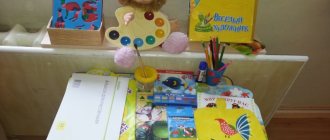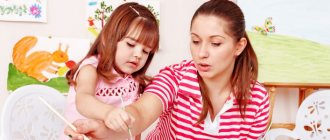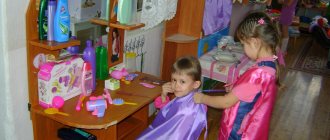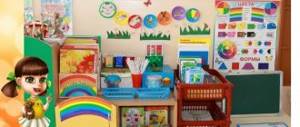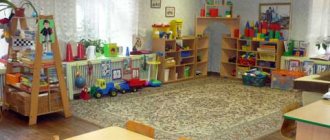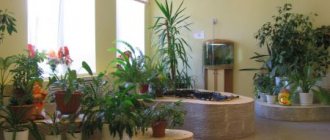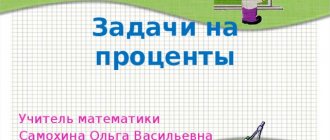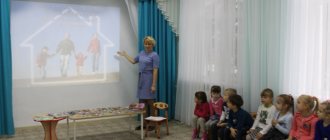Presentation of the group taking into account the Federal State Educational Standard in verse
Communicative activities of preschoolers taking into account the Federal State Educational Standard of preschool education “Autumn has come to visit us” Theme “Autumn has come to visit us” age group: senior Integration of educational areas: “Speech development”, “Artistic and aesthetic.
Test tasks in the implementation of the “Fire Safety” project (taking into account the Federal State Educational Standard) The topic of developing the foundations of safe behavior in children continues to be relevant. Most often, adults themselves endanger their lives.
Lesson summary taking into account the requirements of the Federal State Educational Standard Symbols of Victory Topic: Symbols of VICTORY Objectives: 1) Expand children's knowledge about objects symbolizing victory in the Great Patriotic War. 2) Form.
“Use of the Internet space in working with the parent community, taking into account the introduction of the Federal State Educational Standard” SLIDE 1. Currently, significant changes are taking place in the preschool education system, including in the field of correctional pedagogy.
Modeling the play space in a preschool educational institution, taking into account the requirements of the Federal State Educational Standard The Council of the Ministry of Education and Science of the Russian Federation approved the Federal State Educational Standard for Preschool Education.
Updating the educational process in preschool educational institutions, taking into account the introduction of the Federal State Educational Standard for preschool education. GENERAL CHARACTERISTICS OF FSES STANDARDS - regulatory legal acts of the federal level, which are a set of mandatory requirements.
Subject development environment of the “preparatory “A” group, taking into account the requirements of the Federal State Educational Standard REPORT When organizing the subject environment in the group room, I, as a teacher, took into account everything that contributes to the development of basic characteristics.
The work program of a teacher-psychologist of the MADOE in accordance with the Federal State Educational Standard Explanatory note The work program was developed on the basis of the main general education program of preschool education of the MADOE. Working.
Work program taking into account the Federal State Educational Standard for environmental education “Be a friend of nature” (part 2) 14. The children will humanely handle all objects of nature and observe the rules of safety in nature in relation to themselves. Nature.
Comprehensive thematic planning taking into account the principles of the Federal State Educational Standard The theme of the cycle: “Me and my family.” Topic of the week: “I am growing healthy.” MONDAY: “CLEANITY AND HEALTH” MORNING. Action: “Tamara and I are orderlies” (on duty.
How are groups formed in kindergarten?
Teams in preschool educational institutions are formed for the calendar year. On Internet resources, the site administrator posts text about available or missing places in the garden. Based on the number of available places, new children are admitted based on the documents of their parents (legal representatives). A sample application must be posted on Internet resources and on a stand directly in the building itself, so that the parents of the preschooler can see the design.
For your information! The applicant must present a passport and documents for the child as required by current legislation. The child is enrolled by order, which has a date and number with a field indicating the date from which he will be enrolled.
Throughout the calendar year, enrollment of preschoolers is also carried out (it does not matter whether it is March or November), if there are free places, information about which is also posted on Internet resources and in official social networking groups in a special section.
The routine is mandatory in preschool educational institutions
Formation of groups according to age criteria according to the Federal State Educational Standard
The Federal State Educational Standard regulates formation in preschool educational institutions according to age criteria. This is necessary due to the fact that children of different ages have different needs, they have different skills and abilities, and they have physiological characteristics.
Games for developing memory and attention in children
To organize classes and the educational process, better interaction with teachers and communication with peers, the formation of groups according to this criterion is necessary.
Distribution of children into groups
The distribution of children into groups takes into account their age and state of health, mental and mental development. The number of children in the group is also taken into account. If there are no vacant places for enrollment with this particular teacher, then the child will be enrolled in another group with fewer students.
Each room has its own name (“Bell”, “Teremok”, “Malinka”, “Early Dawn” and others). So, it is easier for children to remember the name, and it also creates a favorable emotional environment. In addition to the name, each group has its own scenario for the holidays and decoration of the veranda and playroom.
Children are divided into groups by age
How many groups are there usually in kindergarten?
The number of groups in kindergarten, of course, may be limited. The main limitation criterion is the design capacity of the building, i.e. area of premises. It also affects the occupancy rate of the institution.
Basic provisions of SanPiN 2.4.1.2660-10 regarding the number of people in a group
SanPiN 2.4.1.2660-10 was approved by the Chief State Sanitary Doctor of Russia on July 22, 2010, Resolution No. 91 and is the main document that must be followed when organizing the activities of a preschool institution.
Important! Groups in preschool educational institutions cannot have more people than are provided for by SanPiN.
The allowed number of people depends on the size of the gaming room. The established area varies for different ages: no less than 2.5 m2 per child for children under three years of age and no less than 2 m2 per child for ages three to seven years. These standards apply to ordinary gardens.
As for kindergartens that develop and use programs specifically designed for children with health problems, the number of pupils is determined in each case individually, taking into account the characteristics of the children. At the same time, it is allowed to form classes of children of different ages in compensatory kindergartens, depending on their developmental characteristics.
The number of children in the group is regulated
SanPiN regulates the maximum permissible number of children in compensatory groups for the age of up to three years, taking into account the violations that children have:
- Deaf and hard of hearing children - 6 people.
- Blind and visually impaired children - 6 people.
- Guys with serious speech problems - 6 people.
- Children with problems in movement and coordination - 6 people.
- With delays in intellectual and mental development - 6 people.
- Complex children with two or more diseases of the body or psyche - 5 people.
- Preschoolers with other health problems - 10 people.
The law also contains material approving the maximum permissible number of children in compensatory groups for those over three years of age, taking into account the violations that children have:
- Deaf children - 6 children.
- Hard of hearing children - 8 little ones.
- Blind children - 6.
- Visually impaired children - 10 people.
- Children with severe speech difficulties - 10.
- Children with speech therapy problems - 12 people.
- Children with limited mobility and poor coordination - 8.
- With intellectual retardation or mental illness - 8 or 10 people, depending on the level of severity.
- Complex children with two or more physical and/or mental illnesses - 5 people.
- Children with other health problems - 15 people.
- Children with autism - 5 people.
Note! Minors with autism are enrolled in a preschool educational institution only when they turn three years old, and a younger child with autism is deprived of the opportunity to attend a state kindergarten. This is due to the fact that older people are easier to socialize and make contact.
Classes on cognitive development in older groups
SanPiN determines the maximum permissible number of children in mixed groups (in the case when the group consists of healthy preschool children and children with health problems).
Important! In this case, the condition of the children is taken into account in each individual case.
The maximum permitted number of children in a team, if the principle is combined:
- Guys under three. The permissible number of people is 10, and preschoolers with special needs are no more than three.
- Children over three years old. The permitted number is 17, and no more than 5 preschoolers with mental illness.
- 4-5 years. The permitted number of children is 15, and preschoolers with poor vision, hearing impairment, and mild mental retardation are no more than four.
- 5-6 years. The maximum permissible number of people is 10, with no more than three blind, hearing-impaired, children with mobility difficulties, or higher-level intellectual problems.
Specifics of the group in kindergarten
A preschool educational institution can form groups not only by age (middle group, preparatory, senior, junior), but also taking into account specialization. Such teams are formed when there is a need for them. Such groups include children with disabilities, developmental delays, and difficulties in communication, socialization, and learning.
There are also options where caregivers can work full-time or can have a short-term schedule. Each kindergarten independently determines the type of groups.
Asthmatics are educated in health groups
Types of specialized groups according to Federal State Educational Standards
Specialization in preschool educational institutions is necessary to effectively achieve educational goals. Depending on the existing characteristics, the baby is enrolled in one or another group in which an educational program is used, developed taking into account special goals and objectives.
What groups of children are there in preschool educational institutions? There are the following types of specialized groups according to the Federal State Educational Standard:
- Wellness. These groups are formed taking into account the visits of children who have serious physical health problems or are simply often ill (for example, those suffering from tuberculosis, constant colds, bronchitis, etc.). These children need a systematic set of health-improving measures and treatment. In addition to the implementation of the educational program of preschool education, regular medical and health measures and procedures are also carried out, taking into account the health status of children.
- General developmental. The most common associations that accept children without any particular physical or mental health conditions. These groups implement educational programs for preschool education, developed by teachers based on the requirements of the Federal State Educational Standard.
- Combined. They represent an association in one team of healthy children and those with health conditions (both physical and mental). This is an extremely effective type, because children with developmental disabilities, communicating with healthy peers, progress more successfully than their peers attending regular preschool groups or receiving home education. The maximum permissible number of such children in a group with healthy children is limited by SanPiN. And in each case, the enrollment of a child in a group is decided individually. His anatomical and physiological state and health status are taken into account. As for the benefits for healthy children in this case, they learn to interact, communicate and communicate with special children who have problems with hearing, vision, musculoskeletal system, and mental development. This improves their communication culture, makes them more humane and tolerant.
- Compensating orientation. They are classes that are formed from children who have developmental differences from their peers. For these preschool children, specially developed educational programs are used.
Groups in the kindergarten are formed taking into account several criteria (age, health status, length of stay). But what is especially important is that when forming groups, the individual characteristics of the physical and mental development of students are always taken into account. It is also correct that the size of groups is limited if they include children with health problems.
MAGAZINE Preschooler.RF
Presentation “Kindergarten in pictures and poems”
teacher of GBDOU No. 23 of the Krasnogvardeisky district of St. Petersburg Maria Nikolaevna Melnik
Children live in kindergarten, play and sing here, find friends here, go for walks with them.
Together they argue and dream, growing up imperceptibly. Kindergarten is your second home, How warm and cozy it is!
You love it, children, The kindest home in the world!
(G. Shalaeva)
Quiet hour:
If we play all day, we might even get tired. And then, saving us, “Quiet Hour” comes to us.
Sleep comes here with it... But sometimes it happens - Toys don’t let us sleep: They get under the pillows,
Under clothes, under the bed - There’s no way to keep them in! We have to get up to explain to the Playfuls,
That they need to try not to scream, not to tumble, not to jump on the beds, but to lie down calmly and sleep.
(E. Grudanov)
Charger:
We arrived, not late, straight to exercise. We tore bananas from the branches and cabbage from the garden.
And like airplanes, we circled in the sky! We got excited, recharged and had fun!
(M. Senina)
In our kindergarten. In our kindergarten there are small tables. In our kindergarten -
Pigeons and rabbits. In our kindergarten - Songs and fairy tales. In our kindergarten -
Cubes and paints. We sit at the table and draw a Christmas tree, Next to the Christmas tree is a house,
Next to the house is a chick. Here is a bird flying, Here is a fox running, The fox has red fur. Whose drawing is the best?
(O. Vysotskaya)
Good deed:
We went to the playground and carried seeds for the birds. The birds wait for us every time, The birds love us very much!
(E. Grudanov)
Our towels:
We drew different pictures ourselves, nailed them over the towels ourselves.
Sasha won’t take Olino’s towel: He won’t confuse the Blue Plane with a bird.
Borya the newcomer knows his boat. Misha - strawberries, Mashenka - a top.
Seryozha has an apple, Volodya has a pear. And Katyusha chose the picture with cherries.
The butterfly is with Igor, the Hare is with Natasha... We don’t confuse our towels at all. Exercises, exercises
We need it as a recharge We are ready for breakfast, laid tables await us It’s interesting to study,
We will learn a lot. We are very inquisitive. You won’t get bored with us. So that we can be healthy.
Let's go outside for a walk. Rain, snow and strong wind can't stop us. We're coming back from a walk,
We wash our hands, we want to eat and willingly, with appetite, whatever they give us, we’ll eat a delicious lunch on the table,
My neighbor is not chatting and the plates are empty, We ate the whole dinner together. Sleep crept up unnoticed,
Covered everyone with a blanket, gave magical dreams like fairy tales to sleepy children, we woke up, stretched,
Turned from side to side, Washed with water, got dressed together We’ll take a walk in the area, Watch the weather
The kids are playing with balls and catches! Dinner!!! Delicious dinner!!! We all really need it! Our parents came for us
We are rushing home to mom. The day has passed, we are not tired, We were having fun playing with friends!
Water, water, Wash my face, So that my eyes shine, So that my cheeks blush,
So that the mouth laughs, So that the tooth bites. We know, we know, yes, yes, yes, where the water is hiding here.
Come out, water, we came to wash ourselves! Lay on your palm Little by little -
No, not a little - Be bolder It will be more fun to wash your face!
Porridge:
Come on, come on, come on, come on! Don't grumble, pots, don't grumble, don't hiss, cook sweet porridge.
Cook the sweet porridge and feed our children.
(I. Tokmakova)
The kitten had a lot of porridge in his cup. Two grouse flew in, two grouse ate the porridge.
And they shout to the kitten: “You’re a mouthful, a mouthful!” If they give you porridge, you need to eat it quickly!
There is a spoon ship in the potato port. The spoon ship sailed with potatoes on board.
The boat floats, floats, rocking on the waves. The boat floats, floats, A. (child’s name) his - am
This is all experiments – Interesting moments! We want to know everything, everything, everything! You need to sketch everything!
How did our experience turn out, How long did it last? We are surprised by everything: How? For what? And why?
(Author Olga Vladimirovna Bogdanova)
Monday to kindergarten
I wake up early.
Children's school day
The most interesting one.
Mathematics. In the morning, apples and pears are piled up in a loud chorus of children.
After sleep, more work: Modeling, drawing. The day has passed, it's time to go home. Sadik, goodbye!
We sing to the piano, and dance and play! We are not bored at all in the spacious gaming room!
And the dolls are never bored in the group! There's a music corner! Children play so loudly in it that even the ceiling shakes!
Presentation of a portfolio of a kindergarten group in verse
Scenario for presenting a portfolio of a group in the kindergarten “Bee”
Relevance Currently, portfolio technology is widely used in the field of education, including in the practice of preschool education. The significance of this technology is as follows. Firstly, it is aimed at the interaction of all participants in the educational process. Children, teachers and parents jointly participate in the creation of a single creative product. Secondly, this is one of the ways to improve the quality of the educational process, since the use of this technology contributes to the achievement of positive results for both the individual (child, teacher) and the team as a whole (group, preschool educational institution). Goal: creating an atmosphere of openness and community among all participants in the educational process. Objectives: - create a situation for the group to experience success; — maintain the interest of group teachers in the formation of a group portfolio; — strengthen interaction with the families of the group’s pupils, increase the interest of parents (legal representatives) in the results of the group’s development and joint activities with the preschool institution. Music sounds and children run into the music room, imitating bees. Children in chorus: Hello, dear guests! Educator 1: Today we are pleased to welcome you to our hive! Group commander: Welcome to the group - Children in chorus: “Bee” Teacher 1: In the group called “Bee” Wonderful boys and girls. They sculpt, draw, dance, sing, live happily and happily together. They learn all the poems together, develop their fingers, and develop their naughty tongue, too, so that their speech sounds clear, like a stream. Educator 2: Here they find friends and go for walks with them. Together they argue and dream, growing up imperceptibly. Kindergarten is your second home, How warm and cozy it is. You love it, children, Children: The kindest house in the world! Group commander: Our motto is Children in chorus: Little bees - They don’t sit idle - They receive knowledge and carry it boldly! They use it deftly in games, songs, and sports. Little bees - Learn by playing! Group commander: Our group’s song is 1. Boys and girls, I made up a game. You and I have become Bees, I’m taking you on a flight. We all need to become friends, We have a swarm of bees. Let's spin around and repeat after me! Chorus 1: We can, we can, we can do amazing miracles, It is only necessary that everyone wants to do it together, It is only necessary that everyone wants to do it together, They want to and fly into the sky! 2. Boys and girls, I’m taking you on a flight. You and I have become bees, we collect honey. How fun it is to circle and buzz over the meadow. We will never offend each other! Chorus 2: We took off, we took off, we took off. How fun we are to spin and buzz. It is only necessary that everyone wants to do it together, It is only necessary that everyone wants to do it together, Never offend anyone! Chorus 1: We can, we can, we can do amazing miracles, It is only necessary that everyone wants to do it together, It is only necessary that everyone wants to do it together, They want to and fly into the sky! La-la-la……………………….. Chorus 2: We took off, we took off, we took off How fun we are to spin and buzz. It is only necessary that everyone wants to do it together, It is only necessary that everyone wants to do it together, Never offend anyone! Chorus 1: We can, we can, we can do amazing miracles, We just need everyone to want to, We just need everyone to want to, Want and fly into the sky Child: We can not only spin and buzz, We also love to dance ! Dance of the Bees Presenter 1: Guys, a new bee has flown into our hive. Just like us, she loves to play, sing and dance, but she is very bored alone. Let's invite her to our family and let's all be friends together! Poems “Our Hobbies” Children: We will now tell you all, Not for entertainment, That we each have our own hobby. 1. Our Vika is so diligent, smart and smart. As soon as he finishes all his work, he runs out into the street. 2. And Lily has manners, squinting her eyes from afar. Apparently, she will be the director of a school or kindergarten. 3. And Sasha the Beauty doesn’t have a tight braid at all. She doesn’t need a pigtail, she’s so passionate about dancing! 4. Nastya likes to play pranks, play and talk. She also loves her name What Anastasia sounds like. 5. And our Artemka has beautiful sneakers. Our Artem plays football, He defends the goal. 6. Our Misha goes to exercise in good spirits, but when it ends, he leaves with regret. 7. Who started up and rushed off like a fast plane? This is Tim in our Marathon running group. 8. Sasha loves Lego very much. He is on friendly terms with the designer. Maybe he will become an engineer, builds buildings and bridges. 9. Our Sasha loves music, He dances and sings, He leads round dances together, In general, he lives happily! 10. Lavrik loves to draw and play ball with his brother. He's a mischievous boy. Just spin like a top. 11. Zhenya loves chocolate, marshmallows, and marmalade. He washes everything down with tea or warm milk. 12. Artyomka has everything laid out on shelves in her head. He will tell you everything with feeling and sense, even about ice cream. 13. Our Arsyusha is great, plays with cubes, and then the whole group takes a long time to assemble them. 14. Ah, our Sasha, Sasha, Two huge eyes. He is his favorite cartoon. He has never missed it. 15. And our Yarik is the most serious of all. He is a good gentleman, both well-mannered and modest. We must follow his example. 16. Don’t look, Mark is fragile, thin and small. It’s not for nothing that he stands at the gate, Agile and attentive. 17. Ah, Maksimka, no matter where, loves exercise. He plays sports, not for fun! 18. Sasha loves to jump, run, and climb everywhere. The teacher says - He is like an energizer. Children in chorus: We told you poems about our hobbies, and now accept some treats from our group! Educator 2: And now, dear guests, we invite you to the group to look at the design of the portfolio.
We recommend watching:
Preschool teacher in raising children Description of the pedagogical experience of a kindergarten teacher on the topic: Plasticineography Education of cultural and hygienic skills. Planning. Preparatory group Project on traffic rules in the preparatory group of preschool educational institutions. Photo
Primorsky district of St. Petersburg
Content
- Information for parents
For you, parents! - Acquisition order
- Payment to the preschool educational institution
- Social protection
- This is interesting
- Playing with children
- Our kindergarten
- Secondary group No. 1 of general developmental orientation “Smile” (from 4 to 5 years old)
- Advice from a senior teacher
- Fire safety
Our gallery
News calendar
| October 2020 |
| Mon | W | Wed | Thu | Fri | Sat | Sun |
| 28 | 29 | 30 | 1 | 2 | 3 | 4
|
5
| 6 | 7 | 8 | 9 | 10 | 11 |
| 12 | 13 | 14 | 15 | 16 | 17 | 18 |
| 19 | 20 | 21 | 22 | 23 | 24 | 25 |
| 26 | 27 | 28 | 29 | 30 | 31 | 1 |
You are here: Home Our groups Senior compensatory group for children with mental retardation “Miracle Island” (from 5 to 6 years old) Presentation “Life in our group”
